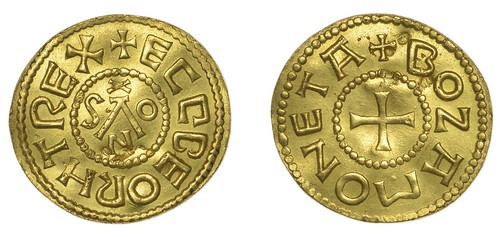
PREV ARTICLE
NEXT ARTICLE
FULL ISSUE
PREV FULL ISSUE
GOLD PENNY OF ECGBERHT OFFEREDDix, Noonan Webb are offering a rare gold penny of Ecgberht. Here's an excerpt from the press release. -Editor A highly important gold Penny of Ecgberht, King of the West Saxons (802-839) is expected to fetch £150,000-200,000 when it is offered in a sale of Coins and Historical Medals on Tuesday, September 7 & Wednesday, September 8, 2021 at international coins, medals, banknotes and jewellery specialists Dix Noonan Webb. This is the only late Anglo-Saxon gold coin in private hands; the other eight specimens are in institutions (the British Museum having seven and another being in Lausanne). The Gold Penny, or Mancus of 30 Pence, was discovered by a metal detectorist at West Dean, on the Wiltshire/Hampshire border, in March 2020, and is unique. It was struck at a West Saxon mint, possibly Southampton or Winchester, and bears the King’s title, ECGBEORHT REX, around a monogram of the word SAXON.
As Peter Preston-Morley, Head of Coin Department at Dix Noonan Webb, commented: Only eight other known gold coins were struck in England between c. 630 and 1257, and as the late Mark Blackburn (Keeper of Coins and Medals at Fitzwilliam Museum, Cambridge) observed, the role of gold in England during the Viking age is a tantalising subject. These gold coins were, in all probability, produced for ceremonial or other high-status payments. It is believed that only on special occasions, perhaps for prestige or, as was the case in the time of Offa, religious events, were orders given for mancuses to be struck. Two other silver pennies of this type, by the moneyer Bosa, were noted by Dr Rory Naismith in his standard work, published in 2010. One is in the British Museum; the other, on a larger flan, was listed for sale by Patrick Finn in 1999. A third penny, found at Fulbourn (Cambridgeshire) in 2011, is recorded and a fourth, found near Wimborne (Dorset) in February 2014, was offered in the Timeline auction, 3 December 2014. All coins are from different dies to the specimen in the auction in September. As Dr Naismith states (The Coinage of Southern England 796-865, pp.43-4), the location of one or more West Saxon mints, which appear to have maintained a low level of production from the late 8th century until the 860s, remains a matter of debate among scholars. Southampton, pre-eminent in the 8th century, had fallen into decline by Ecgberht’s time, while Winchester had primarily been of ecclesiastical importance and was not developed as an urban centre until much later in the 9th century. This new coin is much neater than any of the silver coins. Ecgberht died in 839, and in his will left land only to male members of his family, so that the estates should not be lost to the royal house through marriage. His wealth was no doubt one reason for his ability to purchase the support of the south-eastern church establishment. He was buried in Winchester, as were his son, Æthelwulf, his grandson, Alfred the Great, and his great-grandson, Edward the Elder.
Mr Preston-Morley finishes by saying:
For more information, see:
David Pickup passed along this Daily Mail article with additional text and images. Thanks. -Editor
To read the complete article, see:
Wayne Homren, Editor The Numismatic Bibliomania Society is a non-profit organization promoting numismatic literature. See our web site at coinbooks.org. To submit items for publication in The E-Sylum, write to the Editor at this address: whomren@gmail.com To subscribe go to: https://my.binhost.com/lists/listinfo/esylum All Rights Reserved. NBS Home Page Contact the NBS webmaster 
|

